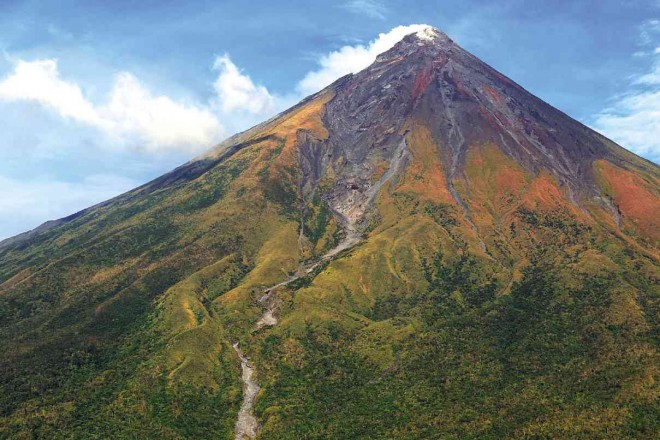Restive Mayon blamed for drop in water supply

AN AERIAL view of Mayon Volcano taken on Aug. 16, a day after its alert level was raised to 2 MARK ALVIC ESPLANA/INQUIRER SOUTHERN LUZON
LEGAZPI CITY—The restiveness of Mayon Volcano has taken a toll on the water supply of Legazpi City.
The city’s water supply has dropped because the major sources of water supplied by Philippine Hydro Inc. (PhilHydro) to Legazpi City Water District (LCWD) are located at the foot of Mt. Mayon, said LCWD spokesperson Richard Atun.
“Based on experience… when Mayon is active, water level tends to decrease, as it causes hot temperature and fast evaporation at the foot of the volcano, where our sources are located,” Atun said.
PhilHydro, a subsidiary of Maynilad Water Services Inc. and the bulk water supplier of LCWD, sources the city’s water from springs located at the boundary of Pawa and Bogtong, from wells in Bogna and Mabinit, and from a spring in Barangay (village) Buyuan, all in the northern part of the city at the foot of Mt. Mayon.
Production loss
Citing water district data, Atun said they had recorded an almost 40-percent production loss because of the condition at the foot of the volcano.
The unstable water supply was aggravated when PhilHydro’s distribution system also suffered after the electric transformer at PhilHydro’s plant exploded last week and was still being repaired.
Since PhilHydro could not yet use its electricity-operated filtration system, this resulted in the distribution of unclean water, Atun said.
The water distributed to LCWD’s more than 21,000 consumers—households and commercial and government offices—was often murky, a yellow-brown fluid that consumers found to be unfit for drinking, cooking, bathing and even washing laundry.
Eduardo Laguerta, resident volcanologist of the Philippine Institute of Volcanology and Seismology (Phivolcs) in this city, confirmed that whenever Mt. Mayon’s abnormality intensified, springs surrounding the volcano dried up.
New lava dome
He said the decrease in the water table around the volcano could be the result of its magmatic activity or bulging or inflation in the volcano’s edifice.
On Aug. 15, the alert level over Mayon Volcano was raised from Level 1 to Level 2 after Phivolcs noted the formation of a new lava dome, which meant that magma was intruding at the crater.
As of Aug. 24, Philvolcs recorded one rockfall in the past 24 hours, as the emission of white steam plumes continued. Sulfur dioxide flux was measured at an average of 1266 tons per day on Aug. 22, three times higher than the sulfur dioxide flux measured at an average of 309 tons per day on Aug. 19.
The public is strongly advised to be vigilant and to desist from entering the 6-kilometer radius of the permanent danger zone to minimize risks from sudden explosions, rockfall and landslides.














